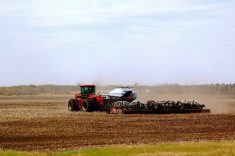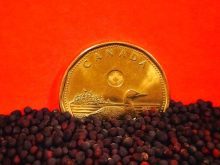Farmland values in Canada, on average, appreciated in 2016 — and while it was less of an increase than the year before, the gain easily beat a bank GIC.
Land prices here in Manitoba, which have been rising steadily since 1992, on average gained 12 per cent in both 2015 and 2014. But after four years of annual double-digit percentage increases Manitoba farmland appreciated 8.1 per cent last year, just slightly higher than the Canadian average increase of 7.9 per cent, Farm Credit Canada (FCC) says in its 2016 Farmland Values Report.
“The rate of increase continues to slow down and we continue to think about that soft landing that we have been talking about for a number of years now,” FCC’s chief agricultural economist J.P. Gervais told reporters during a technical briefing April 6.
Read Also

Alberta crop conditions improve: report
Varied precipitation and warm temperatures were generally beneficial for crop development across Alberta during the week ended July 8, according to the latest provincial crop report released July 11.
Farm cash receipts, the main factor driving farmland prices, have fallen from peaks set in 2012 and 2013, which corresponded with 19.5 and 14.3 per cent increases in the value of Canadian farmland and a jaw-dropping 25.6 per cent increases both years in Manitoba.
Although the final numbers aren’t in, FCC expects 2016 Canadian crop receipts to be up two per cent; Manitoba’s and Alberta’s are forecast to rise 14 and six per cent, respectively, despite challenging growing conditions.
Saskatchewan’s 2016 crop receipts are predicted to drop six per cent as bad weather downgraded crops and prevented farmers from harvesting some crop last fall.
Despite the less sanguine outlook for Saskatchewan, FCC has been doing a brisk business lending money for farmland purchases so far this year, said Scott Sahulka, FCC’s senior director of valuation and environmental risk. While he couldn’t say if Saskatchewan land values will rise as much in 2017, so far “things aren’t selling any cheaper.”
A year ago FCC predicted Canadian farmland values would rise two to four per cent in 2016. Gervais said while he was surprised they turned out to be twice that, it fits with the higher-than-forecast crop receipts farmers are expected to earn.
FCC predicts Canadian farmland values will, on average, rise three to four per cent in 2017, assuming stable crop receipts and interest rates and a 75-cent Canadian dollar.
FCC monitors farmland in 51 regions estimating market value using comparable, arm’s length sales. Because land prices vary significantly, FCC measures land value trends using a percentage instead price per acre.
In 2016 just seven regions didn’t see land values rise, Gervais said.
While FCC pegs the average increase in Manitoba farmland values at 8.1 per cent in 2016, it breaks down the province into five regions. The biggest increase — 11 per cent — was in Central Plains-Pembina Valley, despite weather challenges.
Manitoba’s farmland value increase was the fifth highest in Canada. The biggest jump — 13.4 per cent — was in Prince Edward Island, followed by Alberta, Nova Scotia and British Columbia with increases of 9.5, 9.1 and 8.2 per cent, respectively.
That was followed by Quebec, Saskatchewan, Ontario and New Brunswick at 7.7, 7.5, 4.4. and 1.9 per cent, respectively.
There wasn’t enough data to assess Newfoundland-Labrador land values.
Despite the slower increase in Canadian farmland values, Gervais is still upbeat about Canadian agriculture.
“I believe the demand for Canadian ag products remains really strong both at home and abroad.” he said. “That is supported by a low Canadian dollar, low interest rates as well. From a producer’s standpoint you don’t want to be overly confident about what the markets are going to bring.
“The bottom line is we also have realistic expectations… We’ve basically doubled cash receipts mostly across the country… but I think it would be a little bit unrealistic to expect the next 10 (years) are going to be like the last 10.”
That said, Gervais is “absolutely confident that we can sustain farmland values that we have seen and recorded in 2016 if indeed we are able to sustain farm income. That is the critical variable to monitor as we move forward.”
In contrast, farmland values in the U.S. have been falling. Gervais blames a 30 per cent drop in U.S. farm income in three years. And based on current price projections American farmers won’t be profitable in 2017, he said. Canada’s lower dollar has helped shield Canadian farmers, he said.
Although western Canadian farm income has been weakening, farmers are still generally financial strong, Gervais said. The debt-to-asset ratio is lower than the long-term average, which means farmers will have more flexibility with lenders should revenues fall more than expected.
“So I think we are still in a very strong financial position, liquidity position, if you look at working capital as the first line of defence, is very strong on the prairies given the amazing years we have had over the last five, six, seven years. I think that is reassuring from the standpoint if we do indeed see the Canadian dollar appreciate… or a bit of a softening from an income standpoint given our strong financial position.”
FCC doesn’t expect a higher Canadian dollar or rise in interest rates in 2017, although borrowing costs could increase later this year, Gervais said.
ACROSS CANADA
Provincial farmland values, on average, were all up in 2016, except in Newfoundland-Labrador where there was insufficient data.
Prince Edward Island (P.E.I.) saw the largest jump at 13.4 per cent.
“The main reason for the increases was farming enterprises wanting to gain additional acres to supplement crop rotation cycles and for additional feed production,” Farm Credit Canada says in its 2016 Farmland Values Report.
“The large amount of land sold, as well as the prices these sales generated, placed continued pressure on farmland values. Increases were even seen in marginal or outlying areas, as well as parcels that were difficult to work or had an inferior soil type.”
FCC says some farmers from other provinces sold their operations to buy entire farm operations in P.E.I. to take advantage of less expensive land prices.
“This may be an indication that P.E.I. land prices were still relatively low compared to other Atlantic provinces, prior to the sharp 2016 increase.”
Although P.E.I. saw the biggest jump in land values provincially, the biggest regional jump was 17.7 per cent in B.C.’s south coast region, which includes the Fraser Valley.
The region saw an above average number of farmland sales in the first half of the year, the FCC report says.
“The 17.7 per cent increase was due to continued expansion by local producers, as well as some demand driven by increased interest in rural property. Moderate commodity yields and prices later in the season tempered the farmland market.”
Alberta saw the second highest increase in farmland values in 2016, driven mainly by sales in the northern region, which saw values increase by 11.8 per cent, the report says.
“Land sales took place mostly through auction sales or sealed bids, as grain producers continued to compete for less productive land,” the report says.
Land values in Alberta’s southern region jumped nine per cent.
“Larger farms continued to expand, creating strong demand for all types of land in all areas of the southern region,” the report says. “Irrigation in the southern region also provided contract opportunities for specialty crops and investment by non-typical buyers, who commonly lease back to area growers.”
The Peace region saw the province’s smallest average increase at 7.7 per cent.
“Some adverse weather, as well as depressed oil and gas prices, placed downward pressure on farmland values, while large farm expansion and competition between beef and grains sectors in some areas helped boost the value of marginal cultivated forage or pasture acres,” the report says.
While on average Saskatchewan farmland values rose 7.5 per cent, the southwest region saw land appreciate by 16.6 per cent, in the wake of steady demand.
“Although there were challenges with the lentil harvest, the resulting yields and quality ended up being better than expected,” the report says.
The northwest region continued to see strong demand and increased prices throughout the year, resulting in a 10.3 per cent increase in farmland values, the report says. “Areas with larger farm operations continued to compete for land that came up for sale, causing land values to increase.”
Land prices in the east-central and southeast regions didn’t change in 2016, the report says.
— Allan Dawson is a reporter for the Manitoba Co-operator at Miami, Man. Follow him on Twitter at @allanreporter.




















